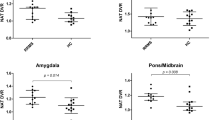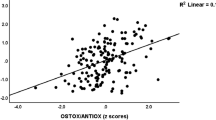Abstract
We have shown that treatment with interleukin-2 (IL-2) or interferon-α (IFNα) may induce depressive symptoms and activation of the cytokine network and that IL-2 treatment may diminish serum dipeptidyl pepdidase IV (DPP IV) activity.1–3 DPP IV (EC 3.4.14.5) is a membrane bound serine protease which catalyzes the cleavage of some cytokines and neuroactive peptides which modulate T cell activity.4 The aims of the present study were to examine the effects of IFNα-based immunotherapy on serum DPP IV activity in relation to induction of the inflammatory response system. In 18 patients with chronic active hepatitis C, we determined the Montgomery and Asberg Rating Scale (MADRS),5 the Hamilton Anxiety Rating Scale (HAM-A),6 serum DPP IV activity, the kynurenine/tryptophan (K/T) quotient, which is an indicator of cytokine (in particular IFN)-induced catabolism of tryptophan,7 and serum interleukin-8 (IL-8) before starting therapy and 2, 4, 16 and 24 weeks after immunotherapy with IFNα. IFNα-immunotherapy significantly suppressed serum DPP IV 2–4 weeks and 16–24 weeks after starting IFNα-based immunotherapy. The reduction in serum DPP IV activity was more pronounced 16–24 weeks after starting immunotherapy than after 2–4 weeks. The IFNα-induced suppression of serum DPP IV activity was significantly correlated to IFNα-induced increases in the MADRS and HAM-A and increases in the K/T quotient and serum IL-8. In conclusion, long-term immunotherapy with IFNα suppresses serum DPP IV activity and the immunotherapy-induced changes in DPP IV are related to increases in severity of depression, anxiety and activation of the inflammatory response system.
This is a preview of subscription content, access via your institution
Access options
Subscribe to this journal
Receive 12 print issues and online access
$259.00 per year
only $21.58 per issue
Buy this article
- Purchase on Springer Link
- Instant access to full article PDF
Prices may be subject to local taxes which are calculated during checkout

Similar content being viewed by others
References
Maes M, Capuron L, Ravaud A, Gualde N, Bosmans E, Bonaccorso S et al. Immunochemotherapy with interleukin-2 and/or interferon-alpha in cancer patients induces lowered serum dipeptidyl peptidase IV activity, which is related to therapy-induced depressive symptoms and immune activation Neuropsychopharmacology 2000 24: 130–140
Bonaccorso S, Meltzer HY, Maes M . Psychological and behavioral effects of interferons Curr Opinion Psychiatry 2000 13: 637–677
Bonaccorso S, Marino V, Biondi M, Grimaldi F, Ippoliti F, Maes M . Major depression induced by interferon-alpha in patients affected by hepatitis C virus J Affect Disord 2001; (in press)
De Meester I, Korom S, Van Damme J, Scharpe S . CD26, let it cut or cut it down Immunol Today 1999 20: 367–375
Montgomery SA, Asberg A . A new depression scale designed to be sensitive to change Br J Psychiatry 1979 134: 382–389
Hamilton M . The assessment of anxiety by rating Br J Psychiatry 1959 32: 50–55
Widner B, Sepp N, Kowald E, Ortner U, Wirleitner B, Fritsch P et al. Enhanced tryptophan degradation in systemic lupus erythematosus Immunobiology 2000 201: 621–630
Maes M . Major depression and activation of the inflammatory response system Adv Exp Med Biol 1999 461: 25–46
Yirmiya R . Endotoxin produces a depressive-like episode in rats Brain Res 1996 711: 163–174
Bluthé RM, Crestani F, Kelley KW, Dantzer R . Mechanisms of the behavioral effects of interleukin 1 Ann NY Acad Sci 1992 650: 268–275
Sakic B, Szechtman H, Braciak T, Richards C, Gauldie J, Denburg JA . Reduced preference for sucrose in autoimmune mice: a possible role of interleukin-6 Brain Res Bull 1997 44: 155–165
Maes M, Meltzer HYM . The serotonin hypothesis of major depression. In: Bloom FE, Kupfer DJ (eds) Psychopharmacology the Fourth Generation of Progress Raven Press: New York 1995 933–944
Maes M, Wauters A, Verkerk R, Neels H, vanGastel A, Cosyns P et al. Lower L-tryptophan availability in depression: a marker of a more generalized disorder in protein metabolism Neuropsychopharmacology 1996 15: 243–251
Maes M, De Meester I, Vanhoof G, Scharpé S, Bosmans E, Vandervorst C et al. Decreased serum dipeptidyl peptidase IV activity in major depression Biol Psychiatry 1991 30: 577–586
Elgun S, Keskinege A, Kumbasar H . Dipeptidyl peptidase IV and adenosine deaminase activity. Decrease in depression Psychoneuroendocrinology 1999 24: 823–832
De Meester IAJ . Characterization of human lymphocytic dipeptidyl peptidase IV and its identification as the activation antigen CD 26 PhD Thesis, Antwerp 1992
Durinx C, Lambeir AM, Bosmans E, Falmagne JB, Berghmans R, Haemers A et al. Molecular characterization of dipeptidyl peptidase activity in serum soluble CD26/dipeptidyl peptidase IV is responsible for the release of X-Pro dipeptides Eur J Biochem 2000 267: 5608–5613
De Meester I, Durinx C, Bal G, Proost P, Struyf S, Goossens F et al. Natural substrates of dipeptidyl peptidase IV. In: Langner J, Ansorge S (eds) Cellular Peptidases in Immune Functions and Diseases 2 Plenum Publishers: New York 2000 67–87
Van Hoof G, Goossens F, De Meester I, Hendriks D, Scharpé S . Proline motifs in peptides and their biological processing FASEB J 1995 9: 736–744
Kehlen A, Gohring B, Langer J, Riemann D . Regulation of the expression of aminopeptidase A, aminopeptidase N/CD13 and dipeptidylpeptidase IV/CD 26 in renal carcinoma cells and renal tubular epitelial cells by cytokines and cAMP-increasing mediators Clin Exp Immunol 1998 111: 435–441
Riemann D, Kehlen A, Langner J . Stimulation of the expression and the enzyme activity of aminopeptidase N/CD 13 and dipeptidylpeptidase IV/CD 26 on human renal cell carcinoma cells and renal tubular epithelial cells by T cell-derived cytokines, such as IL-4 and IL-13 Clin Exp Immunol 1995 100: 277–283
Morikawa O, Sakai N, Obara H, Saito N . Effects of interferon-alpha, interferon-gamma and cAMP on the transcriptional regulation of the serotonin transporter Eur J Pharmacol 1998 349: 317–324
Kamata M, Higuchi H, Yoshimoto M, Yoshida K, Shimizu T . Effect of single intracerebroventricular injection of alpha-interferon on monoamine concentration in the rat brain Eur Neuropsychopharmacol 2000 10: 129–132
Taylor MW, Feng G . Relationship between interferon-gamma, indolamine 2,3-dioxygenase, and tryptophan catabolism FASEB J 1991 5: 2516–2522
Shimizu H, Ohtani K, Sato N, Nagamine T, Mori M . Increase in serum interleukin-6, plasma ACTH and serum cortisol levels after systemic interferon-alpha administration Endocrinol J 1995 42: 551–556
Cavaillon J-M . Les Cytokines Masson: Paris 1996
Recht M, Borden EC, Knight E . A human 15-kDa IFN-induced protein induces the secretion of IFN-gamma J Immunol 1991 147: 2617–2623
Maes M, DeMeester I, Verkerk R, Demedts P, Wauters A, Vanhoof G et al. Dipeptidyl peptidase serum activity in treatment resistant depression: relationships with immune-inflammatory markers Psychoneuroendocrinology 1997 22: 65–78
Nagatsu T, Hino M, Fuyamada H, Hayakawa T, Sakibara S, Nakagawa Y et al. New chromogenic substrates for X-Pro dipeptidyl aminopeptidase Anal Biochem 1976 74: 466–476
Holmes EW . Determination of serum kynurenine and hepatic tryptophan dioxygenase activity by high-performance liquid chromatography Anal Biochem 1988 172: 518–525
Acknowledgements
This work was supported by a grant from the National Council for Research No. 203.04.17 of 09/06/97. We would like to thank Professor Dr S Scharpe, Dr I DeMeester and C Durinx for their valuable help.
Author information
Authors and Affiliations
Corresponding author
Rights and permissions
About this article
Cite this article
Maes, M., Bonaccorso, S., Marino, V. et al. Treatment with interferon-alpha (IFNα) of hepatitis C patients induces lower serum dipeptidyl peptidase IV activity, which is related to IFNα-induced depressive and anxiety symptoms and immune activation. Mol Psychiatry 6, 475–480 (2001). https://doi.org/10.1038/sj.mp.4000872
Received:
Revised:
Accepted:
Published:
Issue Date:
DOI: https://doi.org/10.1038/sj.mp.4000872
Keywords
This article is cited by
-
Associations between expression of indoleamine 2, 3-dioxygenase enzyme and inflammatory cytokines in patients with first-episode drug-naive Schizophrenia
Translational Psychiatry (2021)
-
Leucine competes with kynurenine for blood-to-brain transport and prevents lipopolysaccharide-induced depression-like behavior in mice
Molecular Psychiatry (2019)
-
Serum serotonin, leptin, and adiponectin changes in women with postpartum depression: controlled study
Archives of Gynecology and Obstetrics (2017)
-
The brain reward circuitry in mood disorders
Nature Reviews Neuroscience (2013)
-
Effect of Prolyl Endopeptidase Inhibitor Benzyloxycarbonyl-Methionyl-2(S)-Cyanopyrrolidine on Activity of Proline-Specific Peptidases in Brain Structures of Rats with Experimental MPTP-Induced Depressive Syndrome
Bulletin of Experimental Biology and Medicine (2013)



